Introduction
Product comes through long way from its final stage of production to the customer, and this way is usually called supply chain. Managing this supply chain, people not just take product and put it into the markets, but a complicated decisions and considerations should take place before the product reaches its final consumers. Providing architecture and collaborative supply chain planning, the theme of importance of investigating and collecting information on prospective supply chain partners is going to be analyzed, with the reference to the organizational culture.
Main Body
Supply chain management processes
Starting with the creation of supply chain architecture diagram, the illustration of the depth and breadth of technology will be provided to support some activities in managing supply chain processes. The following steps should be made in order to manage an effective supply chain processes:
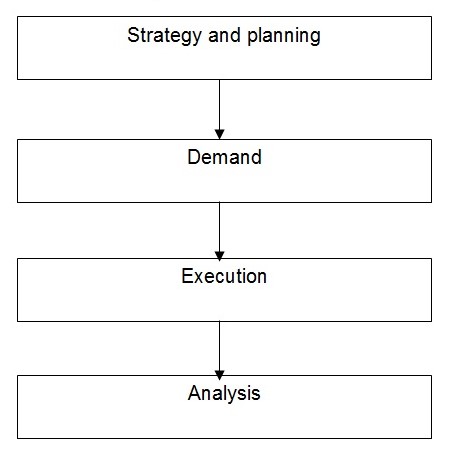
Strategy and planning, demand, execution, and analysis are the stages, which should be seized while managing supply chain. These are the stages, which should be completed before the product is directed to the certain market. The next stages of the product distribution deal with the following processes:
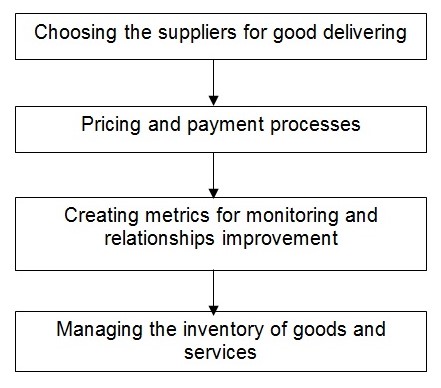
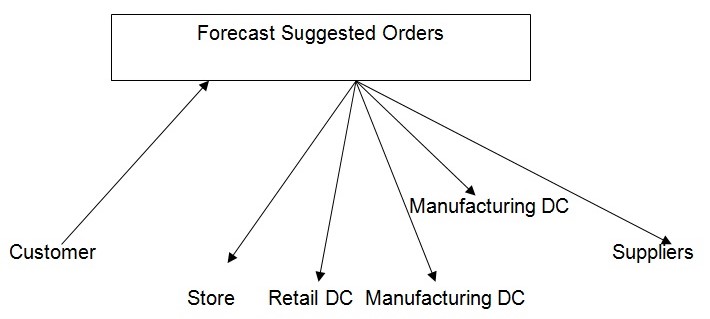
The figure 3 shows the collaboration of Customer and Supplier in the management supply chain. The communication takes place on all stages and continues till the moment the product reaches his customer. It is impossible to argue that communication between customer and supplier is important on all stages. The importance of communication may be explained by the objectives, which are usually provided by the supplier, but are dictated by the customer. The items, which usually direct customers’ choice, may be listed as follows: product/service features, brand image, and price (Bathe par.14). The customers’ aims predetermine the supplier company’s objectives: to provide the customers with the high quality products, with the developed brand name and with the reliable price, which balances quality of the product and is available to the customer.
Before providing the sell-side and buy-side evaluation of the supply chain, the map of supply chain should be created. Considering the above information, which deals with SC architecture, supply chain processes, components of supply chain management, and the objectives of the company, which provides its products to the market, the map of value chain may be created on the example of the publishing house, which supplies its customers with books.
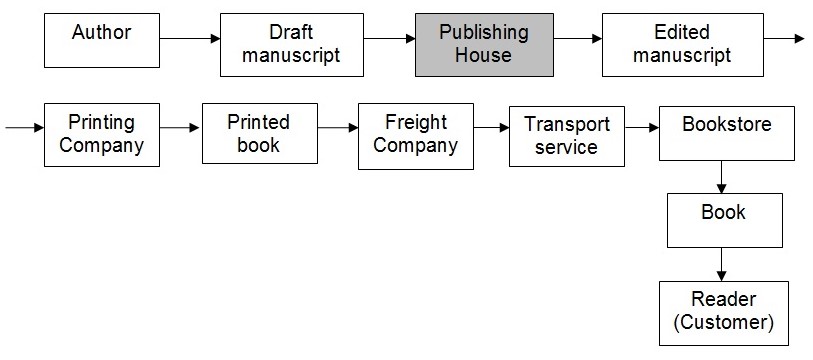
Publishing House, which is highlighted, is the place of our company in the whole supply chain (Andersen, Fagerhaug, and Onsoyen 38). Analyzing the supply chain map, it may be easily investigated the “sell-side” and “buy-side” processes. Taking the basic scheme of the “sell-side” and “buy-side” processes, that is offered in the figure 5.
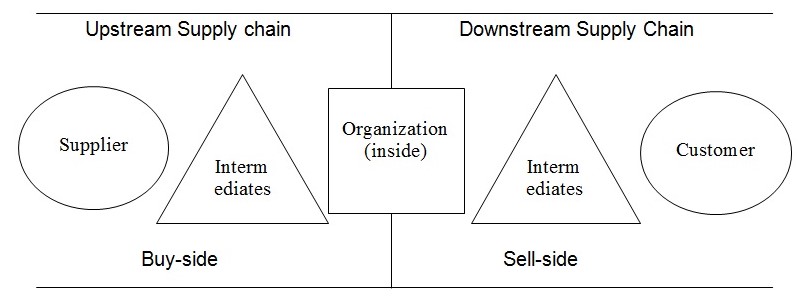
Considering the 5th figure, it may be concluded that all processes and chain elements, which take place before the organization, we introduce (Publishing House in our case), relate to “buy-side” processes, and those, dealing with “sell-side” are on the right, after it (Smith and Chaffey 266). The collaboration on these stages, both “sell-side” and “buy-side”, takes place under the contracts and usually continues for many years, so it may be concluded that the work is automated and collaboration is led easily.
Organizational culture
Organizational culture and choice of partner play a critical part in the success of organizations. The importance of investigating and collecting information on prospective SC partners may never be overvalued, as it is the core principle of the effective functioning of any company. Signing the contract with the partner, the company relies on it, it trusts and there is no place to the discredit. Collecting the information about the future partners, the company gets to know the advantages and disadvantages of the chosen partner, the requests of the other partners, which work with them and their evaluation of the partnering company. This information is important as sometimes the advertising, given by one company, may be easily contradicted by the other and we shall decide by ourselves, whether we need such partner or not.
Considering the question of the consequences of skipping the stage of the information collecting about the future partner may be unpredictable. First of all, the partner may appear to be not so reliable, as it was considered before, and our company may lose some big client or contract for big sum of money because of partner’s irresponsibility. “The wrong partnership may burn up profits, waste valuable staff time and even damage long-term business prospects” says Zeiger (1) in his article. So, skipping the stage of information collecting about the partner may lead to the missing of some important facts about this partner, which in future may result of big costs to the whole company.
Working under the information collection of the company, the following information should be asked and later evaluated:
- The companies, the desired company worked with (to get their opinion later)
- The experience of the company, as the partner of the supply chain management
- The time, they introduce their services on the national and international markets
- The priorities of the company and their vision of the future relations with our company
- The mission and the objectives of the company (both within our company and in general)
- The oriented time of collaboration with our company and their place in these relationships
- The evaluation of the future partner work by their customers (if this information may be checked)
Continuing with the organizational culture, it should be mentioned that it is considered as the collection of different norms, values and patterns, “that is shared by people in an organization and that directs people into specific patterns of performance enhancing or problem solving” (Witte and Muijen 522). The polite and positive directed communication with both customers and partners give the additional points to the name of the company and raises its prestige and mark. The culture on the organization became a crucial question in the companies and now the cultural priorities become to change and overvalued.
Analyzing the culture within our organization, some specific notions and relations should be changed, to my opinion. First, that should be overvalued, is the interaction within organization and with the other partners, as sometimes conflicts appear because of incorrect communication. Second, the environment and the atmosphere in the company should be changed. The change of the atmosphere is possible only with some corrections in the leadership structure. The environment should be friendly and easy, but not tense or stressing. Third, the behavioral norms in the company should be considered and some changes provided in reference to new conditions in the company. Some communication norm and the style of collaboration should be analyzed with the possible corrections providing, that is forth. And the fifth change, which is possible and should be done, is values review, which is considered to be the main change, which should be provided. The enumerated above changes will help to organize the better and more effective work in the company, that will affect the supply chain activities of the company in general.
The evaluation of the supporting culture in the supply chain will be provided according to the following principles, that is the values investigation, communication and behavioral norms following, the environment and general atmosphere should be checked and the norms of communication not inside the company, but also with the other companies. All these facts will help to evaluate and to consider the organizational culture within the partners in the supply chain.
Conlusion
In conclusion, architecture and collaborative supply chain planning, the importance of investigating and collecting information on prospective supply chain partners have been analyzed, with the reference to the organizational culture. The communicational and operational objectives of the company were considered, its place in the supply chain management and the organizational culture of it was evaluated. It was concluded that all parts of the supply chain management are the parts of one system and lacking of one detail or wrong partner choosing may lead to bad consequences for all members of the business.
Works Cited
“Collaborative planning, Forecasting and Replenishment.” DecisionCraft Analytics Ltd, 2004. Web.
“Supply Chain Components.” Section 2. BSBUS616: Plan an e-business Supply Chain. Pdf.
Andersen, Bjørn, Fagerhaug, Tom and Lars E. Onsoyen. Mapping Work Processes, New York: American Society for Qualit, 2008.
Bathe, William D. Neal Stefan. “Using the Value Equation to Evaluate Campaign Effectiveness.” ARF Advertising Tracking and Campaign Effectiveness Workshop, 1996. Web.
Smith, Paul Russell and Dave Chaffey. Emarketing excellence: the heart of ebusiness. Oxford: Elsevier, 2002.
White, Andrew. “The Value Equation: Value Chain Management, Collaboration and the Internet.” Logility, Inc. 1999.
Witte, Karel De and Jaap J. van Muijen. Organizational Culture. London: Psychology Press, 2000
Zieger, Anne. Don’t choose the wrong supply chain partner.” Frontline Solutions. 2003. Web.